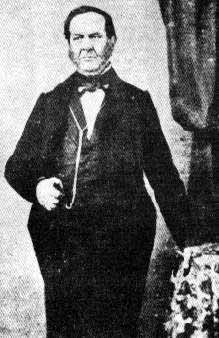Francisco Acuña de Figueroa facts for kids
Quick facts for kids
Francisco Acuña de Figueroa
|
|
|---|---|

Francisco Acuña de Figueroa
|
|
| Born |
Francisco Acuña de Figueroa
July 20, 1790 |
| Died | October 6, 1862 (aged 72) Montevideo, Uruguay
|
| Nationality | Uruguayan |
| Occupation | Writer, poet |
Francisco Esteban Acuña de Figueroa (born September 3, 1791 – died October 6, 1862) was an important Uruguayan poet and writer. He was born and passed away in Montevideo, Uruguay. His father, Jacinto Acuña de Figueroa, worked as the Treasurer for the Royal Treasury.
Contents
Early Life and Studies
Francisco Acuña de Figueroa began his education in Buenos Aires, Argentina. He first studied at the Convent of San Bernardino. Later, he continued his studies at the Royal College of San Carlos.
In 1810, he returned to Montevideo because of an invasion in Buenos Aires. Back home, he started writing poems. At that time, Montevideo did not have a printing press. This meant his poems could not be published yet.
Career and Public Service
Francisco Acuña de Figueroa is famous for writing the words to the national anthems of both Uruguay and Paraguay.
He remained loyal to the Spanish colonial governments. These were the governments that ruled the area before it became independent. When Montevideo was taken over in 1814, he was sent away to Rio de Janeiro. There, he worked as a diplomat for Spain.
His father, however, stayed in Montevideo. The new government kept him in his job because he was very good at it.
Francisco returned to Montevideo in 1818. By then, the city was under Portuguese rule. Besides his writing, he held several important jobs. He became the state treasurer, taking over from his father. He also served on a committee that checked plays in 1846. From 1840 to 1847, he was the director of the Public Library and Museum.
Literary Works
Acuña de Figueroa's poems were first published in a book in 1857. The national anthem of Uruguay, which he wrote, was created in 1833.
He had many other writings, too. He collected them himself in 1848. These works were published after he died, in 1890. They filled 12 volumes and were called "Complete Works." This collection includes many poems and stories. A lot of his writings were satirical, meaning they used humor to criticize things.
In 1965, a selection of his poems was published. This was part of a collection of classic Uruguayan writers.
The Unique Salve Multiforme
One of his most interesting poems is called the Salve Multiforme. The author explained that this poem had two main purposes. One purpose was religious, honoring the "divine queen of heaven." The other purpose was more general or political.
The poem is structured in a very special way. It has 44 sections, each with 26 different ways to say the same thing. You can combine these sections in millions of ways. Each combination creates a complete version of the "Salve" prayer. This means you could read new versions of the prayer for millions of years without repeating one!
Acuña de Figueroa also wrote the lyrics for the national anthem of Paraguay. He passed away in Montevideo on October 6, 1862.
See also
 In Spanish: Francisco Acuña de Figueroa para niños
In Spanish: Francisco Acuña de Figueroa para niños
- National Anthem of Uruguay
- List of Uruguayan writers

